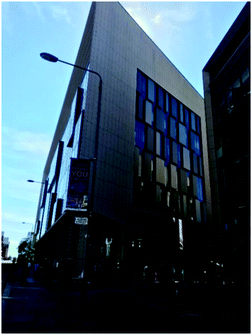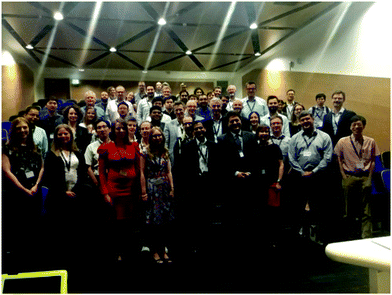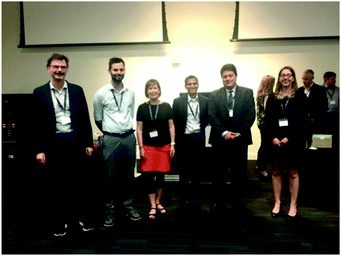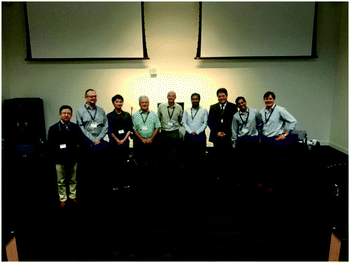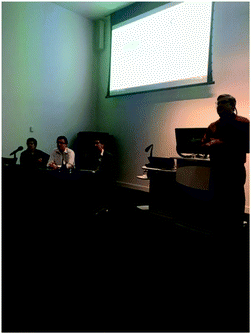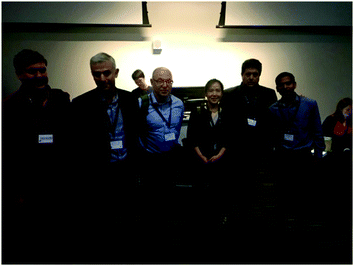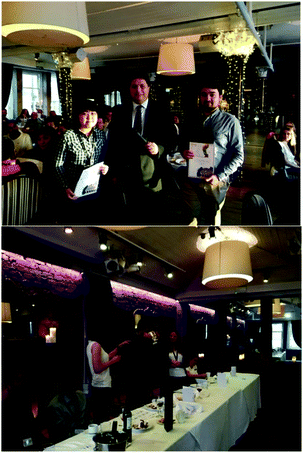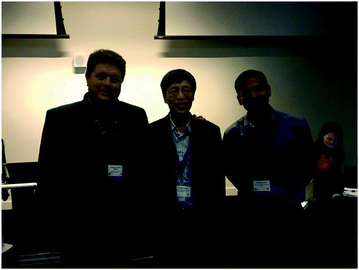Highlights from the Faraday Discussion on Artificial Water Channels, Glasgow, UK
Mihail
Barboiu
 *a,
Manish
Kumar
b,
Marc
Baaden
c,
Philip A.
Gale
d and
Bruce J.
Hinds
e
*a,
Manish
Kumar
b,
Marc
Baaden
c,
Philip A.
Gale
d and
Bruce J.
Hinds
e
aInstitut Europeen des Membranes, Adaptive Supramolecular Nanosystems Group University of Montpellier, ENSCM-CNRS, Place E. Bataillon CC047, Montpellier, F-34095, France. E-mail: mihail-dumitru.barboiu@umontpellier.fr
bDepartment of Chemical Engineering, Pennsylvania State University, University Park, PA 16802, USA
cLaboratoire de Biochimie Théorique, CNRS – UPR9080, Institut de Biologie Physico-Chimique, 13, rue Pierre et Marie Curie, F-75005 Paris, France
dSchool of Chemistry (F11), The University of Sydney, NSW 2006, Australia
eDepartment of Material Science and Engineering, University of Washington, Seattle, Washington 98105, USA
First published on 14th March 2019
Faraday Discussions have a 100 year old format: each speaker submits a full paper in advance and then presents a 5 minute summary of the work at the conference. Each session of presentations is followed by questions and intense discussions from the delegates, who have had the opportunity to read the papers in advance and prepare their questions.This gives the participants the rare opportunity of meeting over the boundaries of the disciplines and the possibility of finding a common language to discuss the topic from various perspectives, a format somewhere between traditional conference questions and live, non-anonymous, peer-review. For the vast majority of delegates, this was their first time attending a Faraday Discussion. It was a unique opportunity to discuss high level projects and results with the people that are developing them.
The Faraday Discussion on Artificial Water Channels was the first of its kind organized on a recently conceived field1–4 and was held from 25–27 June 2018 at the Technology & Innovation Centre at the University of Strathclyde (Fig. 1). It was a nice opportunity to meet promising younger researchers and the world's leading scientists from 21 countries from all corners of the world (Fig. 2), and to have fruitful discussions on the growing importance of Artificial Water Channels. The aim of the discussion was to create conditions for exchange and interaction between the different fields relating to water transport: biological porins, artificial water channels, carbon nanotubes or graphene-based materials and membranes for desalination and water treatment. Despite creative work by chemists to produce sophisticated synthetic architectures confining complex water clusters, most water-channel based work in the past was conducted with natural proteins, used as the selectivity components, embedded in diverse arrays. A recent step was to construct simpler compounds that maintain high-water transport activity and lead to fully synthetic artificial water channels. Moving to simple water-channel systems offers a chance to better understand mechanistic and structural behaviors that might parallel those in biomolecular systems, and move toward the development of desalination membranes embedding artificial channels for highly selective water transport.
Following a welcome and introduction to the format by Dr Mihail Barboiu FRSC (CNRS Montpellier, France), the Chair of the Scientific Committee, and the RSC's Publishing Editors for the event, Suzanne Howson and Sarah Whitbread, the program began with a talk by Professor Peter Pohl from the Johannes Kepler University (JKU), Linz on “Single-file transport of water through membrane channels” (DOI: 10.1039/C8FD00122G, Fig. 3). This talk discussed the evolution of thinking on this topic, starting with a discussion of the simple theory of water diffusion in pores put forward by Alan Finkelstein that proposed that osmotic single channel water permeability could be expected to be inversely proportional to the length of the channel.5 The talk then showed, by citing data from extensive experiments conducted in the Pohl group and other labs, that this was not true and that a more direct correlation can be made between the number of hydrogen bonding sites within water channels and single channel permeability, and further to the relationship between single channel permeability and the Gibbs activation energy barrier for each channel. Another highlight of the talk was the careful experimental procedure that Pohl and co-workers have developed to obtain both single channel water permeability and ion permeability for water and ion channels. While this has not been adopted widely in the water channel field as of yet, the general consensus from the discussions that followed was that such a procedure was necessary for the development of the artificial and biological water channels field. This lecture then allowed the leading authorities from different scientific areas to discuss Artificial Water Channels during four mixed sessions.
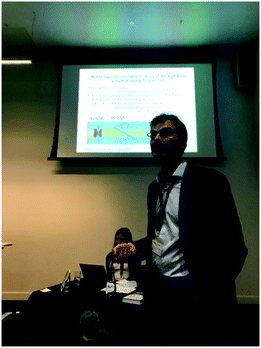 | ||
| Fig. 3 Professor Peter Pohl from the Johannes Kepler University, Linz presenting his Introductory Lecture on single-file transport of water through membrane channels. | ||
Session 1 “Structure and function of natural proteins for water transport”
The talks in this session dealt with water transport in biological transport proteins and its measurement (Fig. 4).Dr Susana Törnroth-Horsefield from Lund University discussed her collaborative work conducted with Stefan Kreida, Jennifer Virginia Roche, Caroline Olsson and Sara Linse on protein–protein interactions regulating aquaporin function (DOI: 10.1039/C8FD00065D). She presented on the Aquaporin-0 (AQP0) calmodulin system that modulates permeability by protein–protein interactions, as well as the AQP2-LIP5 system that modulates membrane permeability by affecting trafficking of AQP-rich vesicles to and from the membrane. Dr Andreas Horner from JKU, presenting on collaborative work with Professor Peter Pohl, followed up on single file transport in biological channels and reported on recent experiments on determining the effect of charge of residues at the entrance of water channels on single channel permeability. He concluded that positive charges at the entrance of channels boost water transport while negative charges do not.6 Dr Aude Sadet from the University of Bucharest, then presented collaborative work with Viorel Nastasa, Cristina Stavarache, Anamaria Hanganu, Dr Andina Coroaba, Dr Alina Nicolescu, Dr Calin Deleanu and Prof. Paul Vasos on an intriguing hyperpolarized NMR based proposal to evaluate water transport across vesicular membranes mediated by channels (DOI: 10.1039/C8FD00021B). This technique holds promise in the future, but is somewhat limited at present due to the sampling interval minimum of 100 ms to 1 s.
After the presentations there was a lively discussion, the main upshot of which was a consensus on the need to develop standard ways of measuring, reporting and comparing single channel water and ion permeabilities. Further, there exists a need to develop orthogonal techniques to measure water and ion permeabilities that go beyond the current stopped flow and electrophysiological techniques. Finally, thinking about trafficking and dynamic membrane integration as an additional way to influence membrane permeability in artificial systems could be a new direction for such systems.
Session 2 “Artificial (biomimetic) water channels”
The second session of the discussion focused on supramolecular approaches to channel like structures (Fig. 5). The early morning session focused on the formation of supramolecular tetrameric structures. Prof. Jeffery T. Davis from the University of Maryland discussed work with Songjun Xiao on the formation of hydrogels from 5-hydrazinoguanosine that self-assembles via the formation of G-quartets into hydrogels in the presence of 0.25 equivalents of KCl (DOI: 10.1039/C8FD00038G). The structural basis of the hydrogel – confirmed by PXRD, IR and CD spectroscopy – is the G4 quartet which formed the basis of the extended 1-D ion channel assemblies. The hydrogel effectively binds anionic dyes, such as naphthol blue black, over cationic dyes. The hydrogel can also be functionalised by reaction with propionaldehyde in either the gas phase or in water solution via formation of covalent hydrazine linkages with the gel matrix. The next two presentations focused on the formation of selective water channels from imidazole-urea building blocks across lipid bilayer membranes. Dr Yves-Marie Legrand presented work with Dr Zhanhu Sun, Dr Istvan Kocsis, Dr Yuhao Li and Dr Mihail Barboiu on structure activity relationships amongst this highly effective class of structurally simple yet highly selective water channel formers via the formation of an ‘I4-quartet’ (DOI: 10.1039/C8FD00024G). A series of imidazole containing systems were prepared with varying chain lengths, different hydrogen bonding linking groups and, in some cases, double-headed systems containing two imidazoles. This study showed the importance of the urea moiety in organising the channel forming units in the lipid bilayer. Dr Samuel Murail then presented work with Tudor Vasiliu, Dr Andrei Neamtu, Dr Mihail Barboiu, Dr Fabio Sterpone and Dr Marc Baaden on modelling of the I-quartet systems using MD simulations (DOI: 10.1039/C8FD00046H). This work looked at the membrane stability of I-quartet aggregates taken from crystal patches, picosecond characterisation of water dynamics and self-aggregation simulations. The work provided two scenarios for the formation of water transport structures: ordered water wires vs. porous sponges.After coffee, the meeting reconvened for four presentations related to functionalised pillar[5]arenes as water channels. Prof. Jun-Li Hou presented work with Jin-Yu Chen, Wei-Wei Haoyang, Min Zhang, Gang Wu and Prof. Zhan-Ting Li on the formation of channels from pillar[5]arene functionalised with chains of Phe–Phe–Phe (DOI: 10.1039/C8FD00009C). Studies showed the incorporation of the compounds into model lipid bilayers which displayed channel-like conductance behaviour. Fluorescently labelled versions of the pillar[5]arenes were incorporated into mammalian cell membranes with a positively charged derivative inserting into the bilayer membrane of rat erythrocytes and human liver carcinoma cells (HepG2). This compound was shown to reduce the cell viability of these cancer cells. The next presentation was by Prof. Harish Vashisth with Daniel Ryan Barden who have looked at the parametrisation and atomistic simulations of biomimetic membranes e.g. block co-polymers with hydrophobic blocks of poly(butadiene) (PB) and hydrophilic blocks of poly(ethylene oxide) (PEO) (DOI: 10.1039/C8FD00047F). They developed all-atom CHARMM force-field compatible parameter sets for various hydrophobic polymers. They also ran simulations of pillar[5]arene-based water channel embedded polymers and showed that the transport characteristics are similar to those observed in lipid bilayers. In the following presentation, Prof. Robert J. Hickey with Chao Lang, Yue-xiao Shen, Jacob A. LaNasa, Dan Ye, Woochul Song, Tawanda J. Zimudzi, Michael A. Hickner, Enique, D. Gomez, Esther W. Gomez and Prof. Manish Kumar discussed creating cross-linked lamellar block copolymer supporting layers for biomimetic membranes (DOI: 10.1039/C8FD00044A). These workers demonstrated the feasibility of using triblock copolymer self-assembled lamellar films to form a matrix that mimics a lipid bilayer membrane. The final presentation of the morning session by Woochul Song with Dr Yue-xiao Shen, Chao Lang, Prantik Saha, Iryna V. Zenyuk, Prof. Robert J. Hickey and Prof. Manish Kumar covered the incorporation of the pillar[5]arene water channels into PB-PEO block co-polymer sheets (DOI: 10.1039/C8FD00043C). The separation properties of these membranes were studied showing several unique selectivity trends.
Session 3 “The modelling and enhancement of water hydrodynamics”
The third session of the discussion focused on modelling water hydrodynamics in nanoscale pores, be it biological or artificial pores. Design principles for further enhancement of water permeation through such pores were considered (Fig. 6). Three complementary papers formed the basis of the discussion opened by Prof. Mark Sansom from Oxford University with a perspective on how to characterize the functional states of such pores, in particular, the ones found in ion channels, through the analysis of the wetting and dewetting behaviors combined with several channel metrics (DOI: 10.1039/C8FD00013A). Such an approach intrinsically requires taking into account the molecular scale dynamics of the pore region and is complementary to a purely geometric consideration of crystal structure pore dimensions. Further conceptual elements were added by Prof. Rob Coalson from University of Pittsburgh describing how complex biological channels, such as claudin, can be examined through simple pore models capturing the essential features of the permeation machinery (DOI: 10.1039/C8FD00073E). A particular focus on the fine water substructures able to develop in these nano-environments was provided and the effect of decorating the pore lining walls with charged groups was described. Selectivity of water vs. ion transport was touched on. Perspectives on using such pores for separation processes were given in the third paper by Prof. Manash Borthakur from the Indian Institute of Technology Guwahati (DOI: 10.1039/C8FD00027A). Using an oriented electric field, effects on a confined water–ethanol mixture in a carbon nanotube environment were characterized, leading to the separation of both solvents under selected conditions.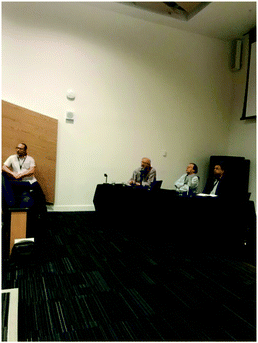 | ||
| Fig. 6 Dr Marc Baaden the chair of Session 3, together with the speakers, from left to right, Prof. Mark Sansom, Prof. Rob Coalson and Prof. Manash Borthakur. | ||
Overall, the high potential offered by molecular simulations to advance our understanding of the molecular level water dynamics in artificial water channels has been brilliantly demonstrated by the constructive exchange with the presenting authors. Several of the stimulating discussions were taken over to the afternoon tea break and received extended attention. A second poster session followed, providing further material to discuss both molecular level but also macroscopic aspects of water transport, permeation and selectivity.
Session 4 “Applications to water transport systems”
The fourth session, Applications to water transport systems (Fig. 7), began with a talk by Dr Claus Helix-Nielsen from Aquaporin A/S and University of Copenhagen on conventional reverse osmosis (RO) membranes integrated with aquaporins (AQP) (DOI: 10.1039/C8FD00061A). The company represents the only commercially available water selective channel product, thus was central to the theme of the session. The paper was focused on a review of large-scale membrane element design and a detailed description of the biochemical process to express and separate AQP in industrially relevant amounts. The overview presentation7 focused on the larger picture of societal needs and the importance of engineering platforms that can be scaled compared to fragile lipid bilayers. This was a critical point since their product is based on conventional interfacial polymerization technology; with the addition of AQP infused vesicles as water channels at the membrane surface. The complication is that the RO membrane platform is itself a water selective membrane and the water flux value is sensitive to polymer processing. This makes it difficult to draw conclusions on the role of AQP channels. Shown in the presentation was an elegant control experiment to make membranes with wild and sequence modified AQP that rendered the channel blocked. The difference between open and closed AQP was roughly a factor of 2 allowing clear demonstration of flow through AQP and relative amount of conventional RO membrane flux. Much of the discussion was focused on ensuring water flux was through AQP and the complexity of RO membrane fabrication as a confounding variable. Estimates of AQP production of 270 gr per year per reactor were sufficient for ∼35![[thin space (1/6-em)]](https://www.rsc.org/images/entities/char_2009.gif) 000 m2 of membrane in idealized monolayer geometry, which is a technically feasible arrangement for the field.
000 m2 of membrane in idealized monolayer geometry, which is a technically feasible arrangement for the field.
This paper was followed by a highly scalable block-copolymer membrane with well-ordered lattices of nm-scale pore by the Nunes’ group at KAUST (DOI: 10.1039/C8FD00015H). Processing conditions of solvent mixtures and evaporation rates were the primary tools of pore control. Discussion primarily focused on flow performance (permeance) and being a potential platform for integration of both protein channels and synthetic channels. Prof. Kazushi Kinbara (Tokyo Inst. Technology) then followed with a detailed study of triblock copolymers that form robust vesicles and channels via pi-stacking regions of designed bipyridine links (DOI: 10.1039/C8FD00022K). Discussion focused on the structure of the channels and the types of selective transport observed.
For the second part of Session 4, Prof. Baoxia Mi (UC Berkeley) followed with an overview of 2-D graphene oxide (GO) membranes, where spacing between planes is controlled by covalent molecular linkers (DOI: 10.1039/C8FD00026C). Clear effects on water flux, ion rejection and molecular weight cut-off were shown. Discussion focused on the 2-D nanofluidics mechanisms in the defect rich GO system and potential linkers to improve performance to the level of being water selective channels. Prof. Gerhard Hummer from Max Planck Institute of Biophysics, Frankfurt am Main then described molecular dynamics (MD) simulations of small diameter CNTs spanning bilayers that complemented the following talk of Alexander Noy (LLNL) with experiments of short CNTs spanning lipid bilayer micelles (DOI: 10.1039/C8FD00011E). In 2001, Prof. Hummer was the first to predict CNTs as a water selective channel with dramatic flow rates8 (equivalent to AQPs) and work of Alexander Noy from Lawrence Livermore National Laboratory had recently shown CNT channels across vesicle walls to develop osmotic driven flow (with some salt selectivity) and similar flow rates.9 The MD simulations showed a surprisingly complex interaction of CNTs with the lipid bilayer with a large degree of angular variation of CNTs spanning the lipid bilayer but importantly, no water flow along the CNT–lipid interface and lipids did not block CNT channels (DOI: 10.1039/C8FD00011E). Noy's experimental results9 were of intensely ultra-sonically cut CNTs (∼1 nm inner diameter, 10 nm length) spanning vesical lipid bilayers and showing predicted high flux/ion rejection as the vesicle shrunk in diameter from induced osmotic pressure and measured by established light scattering techniques. Discussion focused on temperature studies showing the activation energy of water flowing across CNTs being at a relatively high value of 12 kcal mol−1 compared to natural AQP channels near 4 kcal mol−1. An alternate mechanism of water flow through lipid/CNT interface or chaotic motion as opposed to through the CNT core was suggested.10 However MD simulations of Hummer did not show this to be a significant mechanism of water transport (DOI: 10.1039/C8FD00011E). A confounding factor is the pre-exponential of the Arrhenius equation (frequency of attempts varies widely in physical systems) and expected energy barrier of entering the hydrophobic CNT compared to the much shorter AQP constriction point but having unhindered flow after CNT entry. Also non-lipid bilayer CNT membranes from a number of groups see comparable flow rates though without ion rejection (Fig. 8).
The final paper by Prof. Viatcheslav Freger from Technion expanded on the idea that ‘too much success’ in fast flow channels will generate ‘concentration polarization’ by building up too much salt to make very large effective osmotic pressures (effectively a system energy loss) (DOI: 10.1039/C8FD00054A). At a practical level, selectivity is more important than flux (as concentration gradients build, normal channels lose selectivity and stop working). However discussion focused on the fact that AQP has near perfect selectivity and natural systems can have dense aquaporin arrays (as seen in animal eyes). It was agreed that water channels need selectivity as the primary figure of merit and there will be an inevitable trade off in terms of areal density (flow rate) vs. concentration polarization (salt build up on feed side). An order of magnitude reduction in RO membrane area by fast water channels is a reasonable goal for the community.
Poster session and social events
The social and networking periods involved most of the participants, who were actively engaged in discussing the 16 posters which have been presented as flash presentations by the presenters who received many questions on their posters, both by the judges and the delegates. The Faraday Discussions Poster Prize for the best poster was jointly awarded to Miss Shanlin Rao of the University of Oxford, United Kingdom, for her poster on “Hydrophobic gating: A systematic investigation of ion channel structures” and Mr Gianni Klesse of the University of Oxford, United Kingdom, for his poster on “CHAP: A new tool for functional annotation of ion channel structures based on molecular dynamics simulation” (Fig. 9, top).The conference dinner allowed further exchanges and fruitful discussion in a relaxed environment. Most importantly, the participation in the famous Loving Cup Ceremony came as a special particular moment for most of the international delegates; however, everyone played the game until the end (Fig. 9, bottom).
Concluding remarks lecture
The concluding remarks lecture on Artificial water channels: inspiration, progress and challenges was delivered by Prof. Bing Gong from University at Buffalo, USA (Fig. 10).He highlighted that biological channels revealed common structural details behind their extraordinary performances: the presence of a narrow pathway decorated with additional “check points” that provide both confinement and screening for the molecular and ionic species (DOI: 10.1039/C8FD00132D).For water transport, the paramount importance of a sub-nm pore, preferably amphiphilic as shown by AQPs,7 is also shown by CNT pores (see ref. 8-9 and DOI: 10.1039/C8FD00011E), graphene and graphene oxide (DOI: 10.1039/C8FD00026C) channels and more recently by synthetic molecular and self-assembling channels (see ref. 1-4 and DOI: 10.1039/C8FD00024G, 10.1039/C8FD00046H and 10.1039/C8FD00009C). Fabricating biomimetic membranes with water channels incorporated into various 2D matrices, is still in its infancy but this strategy offers a very promising approach for developing the next-generation separation technologies. Important challenges include the precise control of pore length and the reduction of diameter down to the sub-nm range, the uniform or site-specific functionalization of the channel wall, the homeotropic alignment of water-transporting pores and the fabrication of membranes with molecular-thickness. “Examining such artificial channels has yielded fascinating initial results, suggesting that artificial channels with properties paralleling those only observed with biological channels will no longer be a fantasy. Indeed, “There's plenty of room at the bottom” for scientists to play with for years to come” (DOI: 10.1039/C8FD00132D).
Notes and references
- M. Barboiu, Angew. Chem., Int. Ed., 2012, 51, 11674–11676 CrossRef CAS PubMed
.
- M. Barboiu and A. Gilles, Acc. Chem. Res., 2013, 46, 2814–2823 CrossRef CAS PubMed
.
- Y.-X. Shen, P. O. Saboe, I. T. Sines, M. Erbakan and M. Kumar, J. Membr. Sci., 2014, 454, 359–381 CrossRef CAS
.
- M. Barboiu, Chem. Commun., 2016, 52, 5657–5665 RSC
.
-
A. Finkelstein, Water movement through lipid bilayer, pores and plasma membranes. Theory and Reality, J. Wiley & Sons, Inc., New York, NY, 1987, vol. 4, p. 223 Search PubMed
.
- A. Horner, F. Zocher, J. Preiner, N. Ollinger, C. Siligan, S. A. Akimov and P. Pohl, Sci. Adv., 2015, 1(2), e1400083 CrossRef PubMed
.
- F. B. Bjørkskov, S. L. Krabbe, C. S. Nurup, J. W. Missel, M. Spulber, J. Bomholt, K. Molbaek, C. Helix-Nielsen, K. Gotfryd, P. Gourdon and P. M. Pedersen, Sci. Rep., 2017, 7, 16899 CrossRef PubMed
.
- G. Hummer, J. C. Rasaiah and J. P. Noworyta, Nature, 2001, 414, 188–190 CrossRef CAS PubMed
.
- R. H. Tunuguntla, R. Y. Henley, Y. C. Yao, T. A. Pham, M. Wanunu and A. Noy, Science, 2017, 357, 792–796 CrossRef CAS
.
- A. Horner and P. Pohl, Science, 2018, 359, eaap9173 CrossRef PubMed
.
| This journal is © The Royal Society of Chemistry 2019 |

